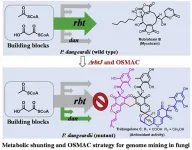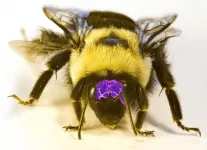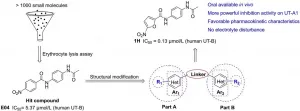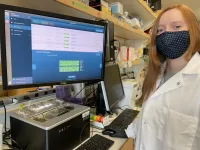New study explains Mycobacterium tuberculosis high resistance to drugs and immunity
2021-04-08
(Press-News.org) A consortium of researchers from Russia, Belarus, Japan, Germany and France led by a Skoltech scientist have uncovered the way in which Mycobacterium tuberculosis survives in iron-deficient conditions by utilizing rubredoxin B, a protein from a rubredoxin family that play an important role in adaptation to changing environmental conditions. The new study is part of an effort to study the role of M. tuberculosis enzymes in developing resistance to the human immune system and medication. The paper was published in the journal Bioorganic Chemistry.
According to the World Health Organization, every year 10 million people fall ill with tuberculosis and about 1.5 million die from it, making it the world's top infectious killer. The bacterium that causes TB, Mycobacterium tuberculosis, is notorious for its ability to survive within macrophages, cells of the immune system that destroy harmful bacteria. Continuing spread of drug resistance of M. tuberculosis to widely used therapeutics over recent decades became a substantial clinical problem. In this regard, the identification of novel molecular drug targets and deciphering the molecular mechanisms of drug resistance are of pivotal importance.
Natallia Strushkevich, Assistant Professor at the Skoltech Center for Computational and Data-Intensive Science and Engineering (CDISE), and her colleagues studied the crystal structure and function of rubredoxin B (RubB), a metalloprotein that ensures the proper functioning of cytochrome P450 (CYP) proteins essential to bacterial survival and pathogenicity. The team hypothesizes that M. tuberculosis switched over to more iron-efficient RubB to survive iron starvation when granulomas are formed (these are largely unsuccessful attempts at defense against TB by the immune system).
"During the long-term co-evolution with mammals, M. tuberculosis developed a variety of strategies to subvert or evade the host innate immune response, from recognition of the bacterium and phagosomal defenses within infected macrophages, to adaptive immune responses by antigen presenting cells.
"Iron assimilation, storage and utilization is essential for M. tuberculosis pathogenesis and also involved in emergence of multi- and extensively-drug resistant strains. Heme is the preferable iron source for M. tuberculosis and serves as a cofactor for various metabolic enzymes. Based on our finding, we linked rubredoxin B to heme monoooxygenases important for metabolism of host immune oxysterols and anti tubercular drugs. Our findings indicate that M. tuberculosis has its own xenobiotics transformation system resembling human drug metabolizing system," explains Natallia Strushkevich.
According to Natallia: New targets for drug design efforts are in great demand and the cytochrome P450 enzymes have emerged as novel targets for the development of tuberculosis therapeutic agents. The classic approaches to block these enzymes are not straightforward. Finding the alternative redox partner, such as RubB, enables further understanding of their function in different host microenvironments. This knowledge could be exploited to identify new ways to block their function in M. tuberculosis.
Earlier research by the consortium showed that one of the CYPs enabled by RubB can act against SQ109, a promising drug candidate against multidrug-resistant tuberculosis. Another study focused on how Mycobacterium tuberculosis protects itself by intercepting human immune signaling molecules -- a hurdle that limits drug discovery.
INFORMATION:
Other organizations involved in this research include the University of Tokyo; Institute of Bioorganic Chemistry, National Academy of Sciences of Belarus; Research Center for Molecular Mechanisms of Aging and Age-Related Diseases, Moscow Institute of Physics and Technology; Institute of Biomedical Chemistry; Pirogov Russian National Research Medical University; Institute of Biological Information Processing (IBI-7: Structural Biochemistry) and JuStruct: Jülich Center for Structural Biology, Forschungszentrum Jülich GmbH; and ESRF ? The European Synchrotron Radiation Facility.
Skoltech is a private international university located in Russia. Established in 2011 in collaboration with the Massachusetts Institute of Technology (MIT), Skoltech is cultivating a new generation of leaders in the fields of science, technology and business, is conducting research in breakthrough fields, and is promoting technological innovation with the goal of solving critical problems that face Russia and the world. Skoltech is focusing on six priority areas: data science and artificial intelligence, life sciences, advanced materials and modern design methods, energy efficiency, photonics and quantum technologies, and advanced research. Web: https://www.skoltech.ru/.
ELSE PRESS RELEASES FROM THIS DATE:
2021-04-08
A great need for better pain treatment
After an appendectomy, a quarter (24.8%) of all children wanted a stronger pain treatment in the first 24 hours after their operation. Among children who had a tonsillectomy, this was one-fifth (20.2%). Analysis of the data showed that this desire was primarily associated with sleep impairments and with movement pain. The lead author of the study, Prof. Ulrike M. Stamer, explained: "We are dealing with a large number of affected patients. Appendectomies and tonsillectomies are the most common operations performed on children overall. Just under a quarter of these cases strongly signal a desire for
improvement".
A comprehensive, multicentre study
This study is based on the international pain registry "PAIN OUT infant", which was established ...
2021-04-08
TAMPA, Fla. (April 8, 2021) -- A dysfunctional immune system significantly contributes to the development of cancer. Several therapeutic strategies to activate the immune system to target cancer cells have been approved to treat different types of cancer, including melanoma. However, some patients do not show beneficial clinical responses to these novel and very promising immunotherapies. In a new article published in Proceedings of the National Academy of Sciences of the United States of America, Moffitt Cancer Center researchers demonstrate how an important defect in STING gene expression in melanoma cells contributes to their evasion from immune cell detection and destruction.
Several different mechanisms have been discovered ...
2021-04-08
Genome mining combined metabolic shunting and OSMAC strategy of an endophytic fungus leads to the production of diverse natural products
Endophytic fungi are promising producers of bioactive small molecules. Bioinformatic analysis of the genome of an endophytic fungus Penicillium dangeardii revealed 43 biosynthetic gene clusters, exhibited its strong ability to produce numbers of secondary metabolites. However, this strain mainly produce rubratoxins alone with high yield in varied culture conditions, suggested most gene clusters are silent. Efforts for mining the cryptic gene clusters in P. dangeardii, including epigenetic regulation and one-strain-many-compounds (OSMAC) approach were failed probably due to the high yield of rubratoxins. A metabolic ...
2021-04-08
A team of archaeologists in north-west the Kingdom of Saudi Arabia has uncovered the earliest evidence of dog domestication by the region's ancient inhabitants.
The discovery came from one of the projects in the large-scale archaeological surveys and excavations of the region commissioned by the Royal Commission for AlUla (RCU).
The researchers found the dog's bones in a burial site that is one of the earliest monumental tombs identified in the Arabian Peninsula, roughly contemporary with such tombs already dated further north in the Levant.
Evidence ...
2021-04-08
Indole, and structures derived from it, are a component of many natural substances, such as the amino acid tryptophan. A new catalytic reaction produces cyclopenta[b]indoles--frameworks made of three rings that are joined at the edges--very selectively and with the desired spatial structure. As a research team reports in the journal Angewandte Chemie, the rates of the different steps of the reaction play a critical role.
Indole derivates are widely distributed in nature; they are part of serotonin and melatonin, as well as many alkaloids--some of which are used as drugs, for example, as treatments for Parkinson's disease. Indole is an aromatic six-membered ring fused to a five-membered ring along one edge. The five-membered ring has a double bond and ...
2021-04-08
Using a surprisingly simple technique, researchers in the University of Arizona Department of Neuroscience have succeeded in approximating how many brain cells make up the brains of several species of bees, ants and wasps. The work revealed that certain species of bees have a higher density of brain cells than even some species of birds, whereas ants turned out to have fewer brain cells than originally expected.
Published in the scientific journal Proceedings of the Royal Society B, the study marks the first time the new cell counting method has been applied to invertebrate animals and provides a robust and reproducible protocol for other research groups studying the brains of ...
2021-04-08
Discovery of novel diarylamides as orally active diuretics targeting urea transporters
Urea transporters (UT) play a vital role in the mechanism of urine concentration and are recognized as novel targets for the development of salt-sparing diuretics. Thus, UT inhibitors are promising for development as novel diuretics. In this study the authors discovered a novel UT inhibitor with a diarylamide scaffold by high-throughput screening. Optimization of the inhibitor led to the identification of a promising preclinical candidate, N-[4-(acetylamino)phenyl]-5-nitrofuran-2-carboxamide ...
2021-04-08
The full assembly of human chromosome 8 is reported this week in Nature. While on the outside this chromosome looks typical, being neither short nor long or distinctive, its DNA content and arrangement are of interest in primate and human evolution, in several immune and developmental disorders, and in chromosome sequencing structure and function generally.
This linear assembly is a first for a human autosome - a chromosome not involved in sex determination. The entire sequence of chromosome 8 is 146,259,671 bases. The completed assembly fills in the gap of more than 3 million bases missing from the current reference genome.
The Nature paper is titled "The structure, function and evolution of a complete chromosome 8."
One of several intriguing characteristics ...
2021-04-08
Using DNA structures as scaffolds, Tim Liedl, a scientist of Ludwig-Maximilians-Universitaet (LMU) in Munich, has shown that precisely positioned gold nanoparticles can serve as efficient energy transmitters.
Since the inception of the field in 2006, laboratories around the world have been exploring the use of 'DNA origami' for the assembly of complex nanostructures. The method is based on DNA strands with defined sequences that interact via localized base pairing. "With the aid of short strands with appropriate sequences, we can connect specific regions of long DNA molecules together, rather like forming three-dimensional structures by folding a flat sheet of paper in certain ...
2021-04-08
It's like something out of science fiction. Research led by Bigelow Laboratory for Ocean Sciences has revealed that a group of microbes, which feed off chemical reactions triggered by radioactivity, have been at an evolutionary standstill for millions of years. The discovery could have significant implications for biotechnology applications and scientific understanding of microbial evolution.
"This discovery shows that we must be careful when making assumptions about the speed of evolution and how we interpret the tree of life," said Eric Becraft, the lead author on the paper. "It is possible that some organisms go into an evolutionary ...
LAST 30 PRESS RELEASES:
[Press-News.org] New study explains Mycobacterium tuberculosis high resistance to drugs and immunity





